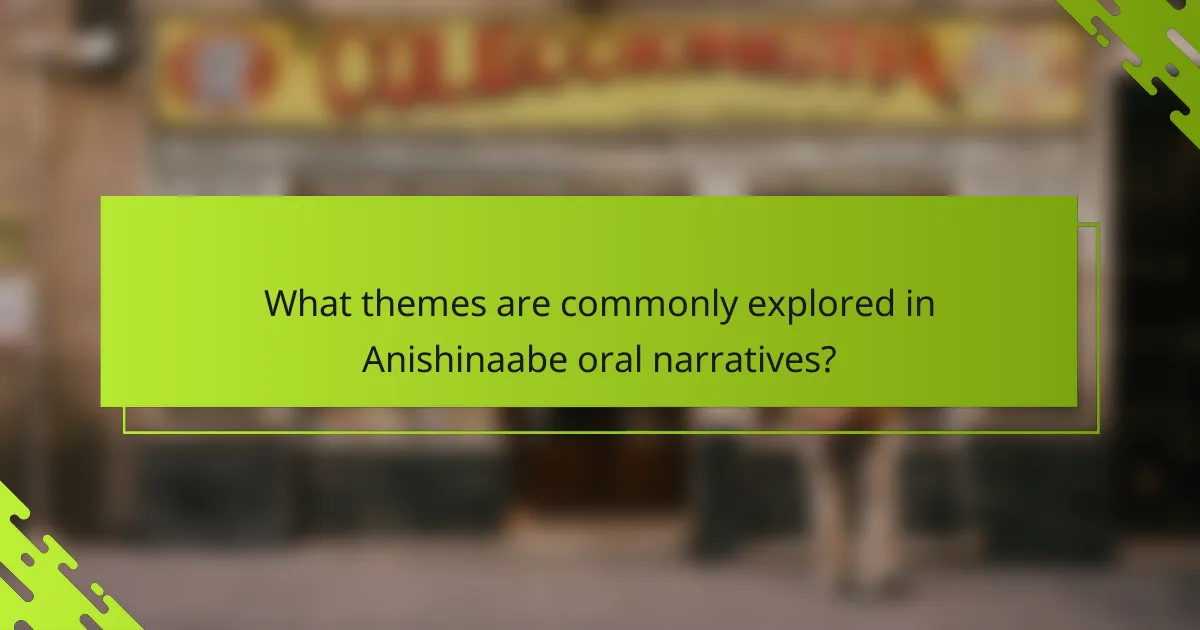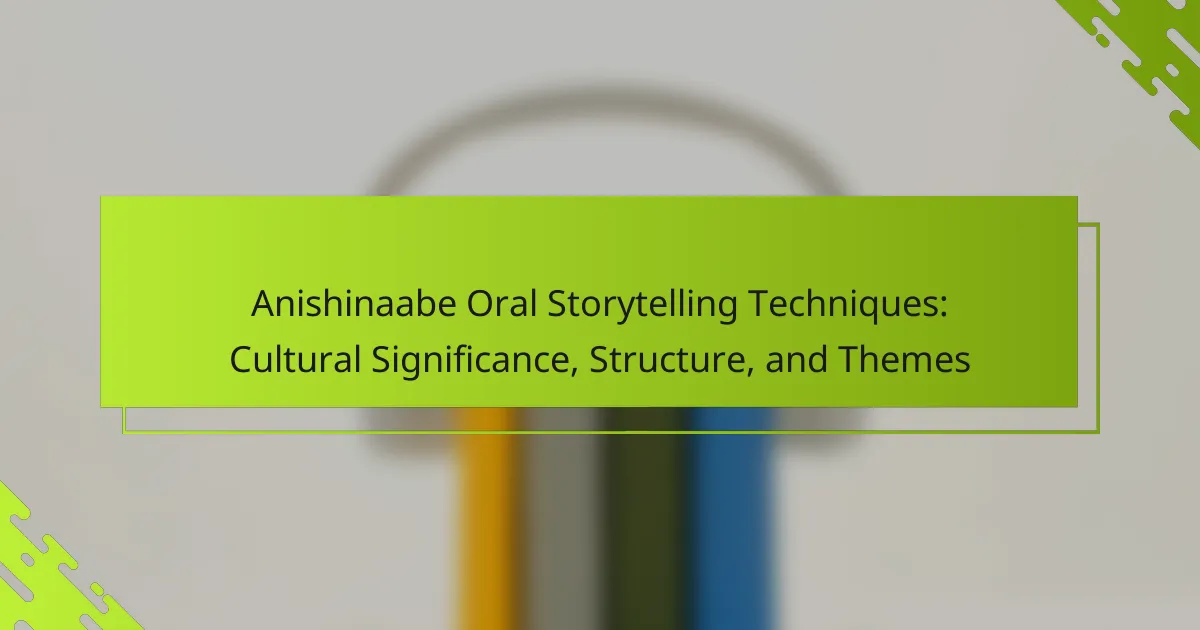Anishinaabe oral storytelling techniques play a vital role in preserving cultural identity and values. This article explores their cultural significance, structural elements, and recurring themes. It examines regional variations and the challenges faced by storytellers today. Notable figures in this tradition, like Basil Johnston and Louise Erdrich, highlight the ongoing relevance of these narratives.

What are the key cultural values reflected in Anishinaabe oral storytelling techniques?
Anishinaabe oral storytelling techniques reflect key cultural values such as community, identity, and respect for nature. These narratives emphasize interconnectedness, teaching moral lessons and preserving history. Storytelling serves as a means of cultural transmission, fostering a sense of belonging and continuity within the community. The structure often incorporates elements like repetition and vivid imagery, enhancing engagement and retention. Themes of resilience and harmony with the environment further illustrate the Anishinaabe worldview, showcasing their values through rich, expressive storytelling.
How do storytelling practices foster community and identity among the Anishinaabe?
Anishinaabe storytelling practices foster community and identity through shared narratives and cultural teachings. These stories often emphasize collective values, traditions, and history, reinforcing a sense of belonging. The structure of oral storytelling includes repetitive elements and vivid imagery, making the narratives memorable and engaging. Themes such as nature, spirituality, and ancestral wisdom are prevalent, connecting individuals to their heritage and each other. As a result, storytelling becomes a vital tool for preserving cultural identity and nurturing community bonds.
Why is oral tradition vital for preserving Anishinaabe history and knowledge?
Oral tradition is essential for preserving Anishinaabe history and knowledge as it fosters cultural identity and continuity. Storytelling techniques transmit values, beliefs, and historical narratives through generations. These narratives often incorporate unique attributes such as specific characters and themes that reflect Anishinaabe worldview. Additionally, oral storytelling serves as a living archive, allowing for adaptability and relevance in modern contexts. The structure of these stories often includes elements like repetition and symbolism, reinforcing communal bonds and shared understanding.

What structural elements define Anishinaabe oral stories?
Anishinaabe oral stories are characterized by a blend of narrative structure, cultural themes, and performance elements. Key structural elements include a clear beginning, middle, and end, which facilitate storytelling flow. Themes often focus on nature, spirituality, and community values, reflecting the cultural significance of the stories. The use of repetition and rhythmic patterns enhances memorability and engagement. Unique attributes may include the incorporation of specific cultural symbols and teachings, which differentiate Anishinaabe stories from those of other cultures.
Which narrative techniques enhance engagement in Anishinaabe storytelling?
Anishinaabe storytelling employs various narrative techniques to enhance engagement, including vivid imagery, repetition, and interactive audience participation. These techniques create a dynamic storytelling experience that captivates listeners and fosters a deep cultural connection. Vivid imagery evokes strong emotions and visuals, while repetition reinforces key themes and messages. Audience participation, such as call-and-response, invites listeners to engage actively, making the stories more memorable and impactful.
How do rhythms and repetition function in these stories?
Rhythms and repetition in Anishinaabe oral storytelling enhance engagement and retention. These techniques create a musical quality, making stories memorable and impactful. Repetition emphasizes key themes and cultural values, reinforcing the narrative’s significance. Such structures also establish a sense of community, as audiences participate in shared rhythms, fostering connection and collective identity.

What themes are commonly explored in Anishinaabe oral narratives?
Anishinaabe oral narratives commonly explore themes of nature, spirituality, community, and identity. These narratives emphasize interconnectedness and reflect cultural values. They often feature animals as characters, conveying moral lessons and teachings. Additionally, stories may address historical events and ancestral wisdom, reinforcing cultural heritage.
How do nature and spirituality intertwine in storytelling themes?
Nature and spirituality are deeply interwoven in Anishinaabe oral storytelling, reflecting cultural beliefs and values. These stories often emphasize harmony with the natural world, illustrating the interconnectedness of all beings. Themes such as respect for the earth, the significance of animals, and the spiritual essence of plants highlight the unique relationship between nature and spirituality. This connection fosters a sense of responsibility towards the environment, reinforcing the teachings passed down through generations. Anishinaabe storytelling serves as a vehicle for cultural preservation, ensuring that these vital themes continue to resonate within the community.
What role do moral lessons play in Anishinaabe stories?
Moral lessons are central to Anishinaabe stories, serving to impart values and cultural teachings. These narratives often highlight themes of respect, community, and the interconnectedness of life. Through storytelling, moral lessons reinforce ethical behavior and guide individuals in making choices. The structure of these tales typically includes relatable characters and situational challenges that illustrate consequences, promoting reflection and personal growth. This unique attribute of storytelling fosters a collective identity and preserves cultural heritage among the Anishinaabe people.

How do regional variations influence Anishinaabe storytelling practices?
Regional variations significantly shape Anishinaabe storytelling practices through diverse themes, styles, and cultural elements. Different regions influence the narratives, reflecting local histories and environmental contexts. For instance, stories from the Great Lakes may emphasize water and fishing, while those from the prairies highlight land and agriculture. This geographical diversity enriches the oral tradition, ensuring it remains relevant and resonant across communities. Additionally, regional dialects and languages infuse unique expressions and metaphors, further distinguishing storytelling practices. These variations uphold cultural identity and continuity, illustrating the adaptability of Anishinaabe oral traditions.
Which local dialects affect storytelling styles and themes?
Local dialects significantly influence Anishinaabe storytelling styles and themes through unique linguistic features and cultural expressions. Each dialect carries distinct vocabulary and idiomatic phrases, shaping narrative structures and character portrayals.
For example, the use of regional metaphors enriches storytelling, allowing deeper connections to nature and community. Dialects also reflect variations in oral traditions, impacting themes of identity, spirituality, and moral lessons. These elements create a rich tapestry of storytelling that honors local heritage while preserving cultural significance.
Cultural context plays a crucial role, as dialects encapsulate historical experiences and collective memory. This results in storytelling that resonates with specific audiences, fostering a sense of belonging and continuity. The interplay between dialect and narrative style enhances the depth and authenticity of Anishinaabe oral traditions.
How do contemporary influences shape modern Anishinaabe narratives?
Contemporary influences significantly shape modern Anishinaabe narratives through the integration of current social issues and technology. These narratives adapt to reflect contemporary themes, such as identity, resilience, and environmental concerns. The use of digital platforms allows for broader dissemination and engagement with traditional storytelling techniques, enhancing cultural preservation. Additionally, collaborations with other cultural groups enrich the narratives, fostering a dynamic exchange of ideas. This evolution highlights the adaptability of Anishinaabe storytelling while maintaining its cultural significance.

What challenges do Anishinaabe storytellers face today?
Anishinaabe storytellers face challenges like cultural erosion, audience engagement, and preservation of language. These obstacles stem from modernization and a decline in traditional practices. Additionally, access to platforms for storytelling is limited, impacting the reach of their narratives. The struggle to maintain authenticity while adapting to contemporary contexts further complicates their efforts.
How does digital media impact the transmission of oral stories?
Digital media enhances the transmission of Anishinaabe oral stories by expanding their reach and preserving cultural nuances. Through platforms like social media and podcasts, storytelling techniques adapt to modern audiences while maintaining traditional structures. This integration allows for a broader audience engagement, ensuring that themes of identity, community, and history resonate across generations. The unique attribute of digital media is its ability to capture and disseminate oral narratives in diverse formats, preserving the essence of storytelling while facilitating contemporary interpretations. As a result, the cultural significance of oral traditions is reinforced, fostering a sense of belonging and continuity within the Anishinaabe community.
What strategies are employed to keep storytelling traditions alive in a modern context?
Anishinaabe communities employ various strategies to keep storytelling traditions alive in a modern context. These strategies include integrating oral storytelling into educational curricula, utilizing digital platforms for wider reach, and hosting community gatherings to encourage participation.
Moreover, mentorship programs connect elders with youth, fostering intergenerational knowledge transfer. Storytelling festivals celebrate cultural narratives, enhancing community pride and engagement. Additionally, the adaptation of traditional stories into contemporary formats, such as theatre and film, makes them accessible to younger audiences. These approaches ensure the cultural significance of Anishinaabe oral storytelling endures in today’s society.

Which notable Anishinaabe storytellers have influenced the craft?
Notable Anishinaabe storytellers include Basil Johnston, who emphasized the connection between stories and cultural identity, and Louise Erdrich, known for her narrative style blending personal and communal themes. Their works have profoundly influenced the preservation and evolution of Anishinaabe oral storytelling techniques. These storytellers incorporate traditional structures and themes, maintaining cultural significance while adapting to contemporary contexts.
What unique contributions have individual storytellers made to the tradition?
Individual storytellers in Anishinaabe culture have enriched oral storytelling through unique personal experiences and perspectives. They contribute distinctive themes, character portrayals, and narrative styles that reflect their individual backgrounds. For instance, some storytellers emphasize environmental connections, while others focus on community values and teachings. The diversity of these contributions fosters a rich tapestry of cultural expression, ensuring the tradition remains dynamic and relevant. Each storyteller’s unique voice enhances the collective knowledge and wisdom passed down through generations, reinforcing the significance of oral storytelling in Anishinaabe culture.
How do personal experiences enrich storytelling practices?
Personal experiences significantly enhance storytelling practices by providing authenticity and emotional depth. In Anishinaabe oral storytelling, personal narratives connect listeners to cultural heritage and shared values. These stories often reflect unique life experiences, allowing storytellers to convey lessons and morals effectively. The integration of personal elements fosters a sense of community and belonging, reinforcing cultural identity and continuity. Through this process, storytelling becomes a dynamic exchange that enriches both the teller and the audience, preserving traditions while adapting to contemporary contexts.
What practical tips can enhance the effectiveness of storytelling in the Anishinaabe tradition?
Incorporating practical tips can significantly enhance storytelling effectiveness in the Anishinaabe tradition. Focus on using vivid imagery to create strong visual connections for the audience. Engage with the audience through interactive elements, such as asking questions or encouraging participation. Emphasize the use of traditional language and phrases to maintain cultural authenticity and deepen emotional resonance. Structure stories with clear beginnings, middles, and ends to ensure coherence and flow. Lastly, integrate personal experiences and community values to make the narrative relatable and impactful.
